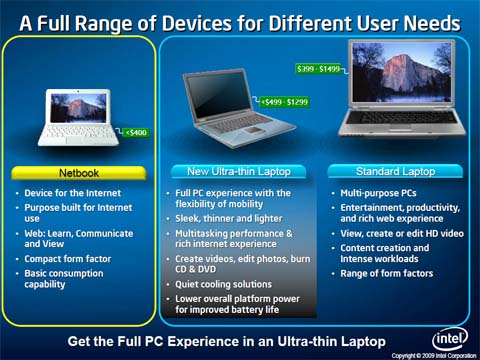Intel finally announces ULV, drops the "C"

Intel announced its latest ultra low-voltage (ULV) processors at the start of the Computex trade show in Taiwan this week. The announcement was no surprise: Intel and computer makers have been talking about the chips (previously known as CULV for "consumer") for months, and in April MSI even announced a laptop, the X-Slim series X340, supposedly based on one of the new ULV chips.
Nevertheless the announcement is significant because these ULV chips will support a new class of ultra-thin laptops that will cost anywhere from $399 to $2,000. The processors use a maximum of about 10 watts, compared with 25W-35W for a typical laptop, which means computer designers can easily squeeze them into laptops less than an inch thick that, Intel says, will have all-day battery life without resorting to an extended battery that juts out the back.
Though the announcement refers to "ULV processors," Intel announced only one new ULV chip, a 1.3GHz Intel Pentium SU2700. In fact, Intel already sells several others. The other chips in the ULV lineup range from the 1.2GHz Intel Celeron M 723 ($107) to the Core 2 Solo SU3300 (1.2GHz; $262) and SU3500 (1.4GHz; $262) and the Core 2 Duo SU9300 (1.2GHz; $262), SU9400 (1.4GHz; $262) and SU9600 (1.6GHz, $289). Here's Intel's micro-site on ultra-thin laptops, which shows the entire line.
As these prices suggest, up to now these ULV chips have mainly been used in relatively high-priced ultraportables and thin-and-lights such as the such as the Lenovo ThinkPad X301, which starts at $2,000 with the SU9400. The real news here is that Intel will be selling lower-priced ULV chips to broaden this market. The company hasn't announced the pricing for the SU2700, but it will obviously fall somewhere between $107 and $262. I wouldn't be surprised to see lower prices for the existing ULV chips sometime soon as well.
Along with the new chip, Intel announced a "value" chipset, the GS40 Express, for ULV laptops that supports Windows Vista Home Premium and the Aero interface, HD video playback and HDMI. These capabilities clearly distinguish ultra-thin laptops from netbooks, nearly all of which can't handle these tasks today (though Nvidia's Ion platform could change that). This slide shows how Intel sees this new class of laptops fitting in between netbooks and other notebooks:
AMD is also going after this in-between segment with its AMD Athlon Neo chip, which is currently used in the 12-inch HP Pavilion dv2z.
The fastest growth in laptops has been not only in highly portable ones with displays that are 14 inches or smaller, but also in laptops with displays measuring 16 inches or larger (basically the mainstream 15-inch model is gradually being squeezed out). With that in mind, Intel also announced several new standard voltage chips. These include the 3.06GHz Core 2 Duo T9900, 2.8GHz P9700 and 2.66GHz P8800. Intel hasn't announced the pricing on these, but several sites have speculated that they will have the same prices as current top-of-the-line chips (which will get lower prices) including the $530 T9800, $348 P9700 and $241 P8800.
